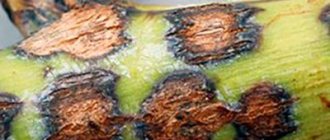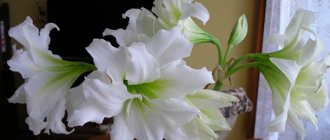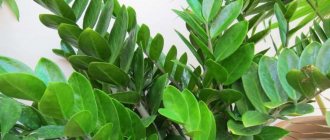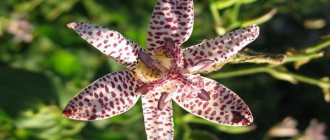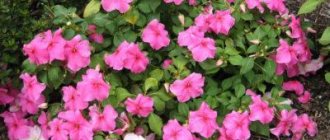Zamioculcas zamiifolia is a unique species found in Mozambique and Madagascar. This is a large herbaceous plant with shiny leaves. In addition to its scientific name, it is called the “dollar tree.” According to legend, the plant attracts material wealth to the home, so it is used to decorate offices and banks. The crop has many varieties, differing in the height of the bush, shape or color of the leaves. One of the most spectacular varieties is Zamioculcas black.
Detailed description
Black Zamioculcas (Zamioculcas Black Raven) is also known as Zamioculcas Black Prince, Black Raven, Raven (Raven) . The culture received its last name for the similarity of the shape and color of the leaves with a raven’s wing.
The height of an adult plant is 75 cm. The leaves are ovoid, glossy, complex pinnate, grow from a fleshy tuber located underground. The leaves have a swollen thickening at the bottom. The appearance of the plant looks unnatural: the leaves are so dark that they appear black. The plant acquires such a beautiful color as it matures. In young specimens (up to a year), all their parts have a soft light green color.
The flower grows slowly: per year - only 10-15 cm.
Attention! The plant has no stems! Zamioculcas leaves have long, thick petioles that are mistaken for stems.
Black Zamioculcas: description, occurrence
Zamioculcas Black Raven is native to the arid regions of Madagascar. About 20 cultivated varieties of the plant are known. The most unusual of them is Raven.
The plant can reach 1.5 meters in height. The main difference of the variety is its black-purple leaves. They have a rounded-pointed shape and are located symmetrically along the length of the stem. Black Zamioculcas received the nickname “Raven” for the similarity of the stem to the straightened feather of a bird.
Zamioculcas Zenzi
Breeders have developed a miniature species of shrub with black leaves - Zamioculcas Zenzi, the description of which says that it is distinguished by short internodes and a thicker trunk.
Photo of this variety of dollar tree
Below you can see what the plant looks like:
Types of homemade Zamioculcas with photos and names
The perennial shrub belongs to the Araceae family and grows in the mountains and tropical jungles of East Africa. Zamioculcas zamifolia is the only species in its genus, and a variegated subspecies has already separated from it.
Zamioculcas zamiifolia
Zamioculcas zamifolia is a succulent with thick cylindrical shoots growing vertically. On them alternately on short petioles there are leaves with pointed tips. They are painted in a uniform dark green color, with shallow furrows running along the veins.
Interesting! Brown-purple spots with uneven outlines appear on the trunks of adult zamioculcas. no need to worry: this is a normal stage of flower development, and not a sign of disease.
Zamioculcas variegate
The variegated subspecies of Zamioculcas is distinguished by its spectacular leaf color. They are characterized by smooth transitions between yellow and green shades, and there are even colorless areas.
This diversity is actually due to a mutation in the genome of Zamioculcas, due to which most of it loses the ability to photosynthesize.
Succulent leaves are located opposite each other.
Bloom
Zamioculcas black will please its owner with flowering only with very good care. The Black Crow blooms very rarely under ideal conditions - once every 3-5 years .
When and how does it bloom?
Flowers appear at the end of winter - in February. The inflorescence is a complex spadix of creamy green color, surrounded by a greenish spathe. The length of the inflorescence together with the short peduncle varies from 7 to 20 cm.
What do the fruits look like?
The Zamioculcas inflorescence has an interesting structure: female flowers are located at the bottom of the spadix, followed by a zone of sterile flowers, and male flowers are located in its upper part. In nature, the plant is pollinated by small insects and wind . The fruit is a brown multi-seeded berry. It does not ripen at home.
Trimming
Pruning is not a prerequisite for proper plant care. It is carried out only to give it a certain shape or rejuvenation. You can trim any part of the plant: tuber, leaves, cuttings. The main thing is that the pruning tool is very sharp and sterile. A scalpel, garden pruning shears, and a sharp knife will do.
Also read: Top 15 rare species of succulents with photos and names. Choose a plant to your liking!
The cut area must be sprinkled with crushed activated carbon. This will quickly stop the leakage and block access to the “wound” for pathogenic microorganisms. Often pruning is used to treat the currency tree.
Landing technology
After purchase, the plant is placed away from the crops available in the house. Such quarantine is necessary to acclimatize the flower and identify possible pests. After 5 days they begin planting.
Choosing a pot
Choose a pot 1-2 sizes larger than the root ball. The ideal option is a ceramic pot, narrowed at the bottom, with a drainage hole.
What should the soil be like?
To prepare the substrate yourself, take (ratio in parts):
- peat – 2 hours;
- sand – 1 hour;
- humus – 1 hour;
- fine expanded clay – 1 tsp.
If it is not possible to prepare soil for a succulent, buy it at the store. For Zamioculcas, a cactus mixture is suitable.
How to plant?
Planting technology is simple:
- Remove the flower from the pot and shake off excess soil.
- Coarse expanded clay is poured onto the bottom of the new container.
- On top is a layer of soil on which the plant is placed, straightening the roots.
- The roots are covered with soil so as not to bury the plant.
After planting, the flower is watered and the drained water is drained from the pan.
Purchase and adaptation
This variety is quite rare; you can only buy it in the online store by pre-order. Such exotica costs a lot - you will have to pay at least 3,000 rubles for a young plant.
Immediately after purchasing Raven, it is better to quarantine it in a cool, shady place, separate from other plants.
It is important to correctly adapt the flower to the conditions of the house: first it must get used to the microclimate of the home and only after 2-3 weeks the flowerpot is placed in a permanent place, and after another week it is transplanted into new soil.
Home care
Unlike other varieties and hybrids, black zamioculcas is not only distinguished by its spectacular appearance, but also by its absolute unpretentiousness to growing conditions.
Temperature
Throughout the entire season, the plant enjoys a comfortable temperature within 18-22°C.
Lighting
This variety is afraid of direct sunlight . If the room's windows face the sunny side, place the flower pot deep into the room. Then the incident light will be diffused and will not cause harm to the pet.
Reference! Light intensity does not affect the brightness of leaf color. Even if the flower is in the shade, it will have a rich black color.
Watering
Like other varieties and hybrids of Zamioculcas, “Black Crow” is a succulent.
This means that the crop is able to accumulate water inside storage tubers, leaves, stems, and then consume it.
The main rule of watering is moderation . It is almost impossible to dry the plant.
Watering is carried out with settled water at room temperature. After watering, the water is drained from the pan.
Top dressing
During the growth of new leaves, in March, the first fertilizing with complex fertilizer for indoor plants begins.
Trimming
As zamioculcas grows, the leaves naturally die off. To prevent the bush from losing its decorative appearance, they are cut with a sharp knife, leaving a small stump (2-3 cm) above the ground. The cut area is sprinkled with crushed coal.
For large trees, formative pruning is carried out in the spring, cutting out heavy leaves along the edges, giving the crown neatness. The cut leaves are used as propagation material.
Transfer
Young plants are replanted annually, large plants - once every 3-5 years . The fact that Zamioculcas needs replanting is indicated by the roots emerging from the drainage hole. For transplantation, select a pot with a diameter one size larger than the previous one. The best time for transshipment is spring.
If the transplant is unscheduled (in case of illness), it is performed in any season. Shake off all the soil from the roots, cutting off the rotten ones.
Care during the flowering period
The plant blooms inconspicuously , so it does not require any care to maintain flowering. After flowering, the flower stalks are cut off, and the cut points are sprinkled with charcoal powder.
What to do if it doesn't bloom?
Black zamioculcas rarely blooms even in ideal conditions. There is a sign that if zamioculcas blooms in the house, there will be some kind of happy event (wedding, news of pregnancy, material luck). You can stimulate the flowering of the plant by placing it on a bright eastern window.
Reproduction methods
Despite the exoticism and apparent difficulty of growing, this variety is not at all difficult to propagate. There are several ways to expand your collection of these unusual succulents.
Leaf propagation
One or more small leaves are separated from the large black “feather”. Each of them is cut in the petiole area and set aside to dry in a dark place. After 2-3 days, when the material dries, it is kept in the Kornevin preparation.
Some gardeners prefer to germinate Zamioculcas in ordinary wet sand.
Containers with the substrate are prepared in advance. It should be light and moisture-permeable. The leaf is placed inside and covered with a jar or film. The greenhouse effect will provide additional stimulation of root formation. The plant is not watered during germination.
Cuttings
Nodules form at the base of the leaves
If you carefully examine an adult Black Zamioculcas bush, you will easily notice an interesting thing: small nodules form at the base of some leaves.
This means that such a leaf can already be separated from the mother plant and planted separately. This is a cutting from which a new bush will soon grow.
The leaf is planted in a container with soil so that the tuber is completely covered with soil. It’s better to make a small greenhouse over the sheet at first - cover it with a large jar or make a frame from slats and wrap it with film. In such conditions, the seedling will take root faster and grow new roots.
Dividing the bush
This method of reproduction is the fastest, but also quite risky. If the outcome is favorable, the grower will have several full-fledged adult Zamioculcas bushes at once. However, if the procedure is carried out incorrectly, it is easy to ruin them all.
Only an adult and healthy zamioculcas with several tubers at the base is suitable for division. It is completely removed from the soil and shaken off to assess the condition of the tubers and their number.
The bush is carefully divided so that each of them has its own growing point. Next, they are seated in separate containers according to the rules described above and placed in a warm place without direct rays. When the seedlings take root and grow, they are placed in a permanent place in the room.
Propagation by seeds
If Zamioculcas has bloomed, its seeds are suitable as planting material.
Sand is poured into a shallow container and moistened. Seeds are sown on top and, without sprinkling them with soil, they are covered with glass or film. The greenhouse is placed under a lamp to ensure a constant temperature of +28°C.
Shoots appear in 10-14 days, but the greenhouse cannot be opened immediately. The sprouts should strengthen for about two more weeks, until they can be slowly ventilated, accustoming them to lower temperatures.
With this method of propagation, the culture develops very slowly. It can take 1-2 years from the first shoots to the state of a full-fledged bush.
Diseases and pests
The plant can become sick due to improper watering. If there is excess moisture, the roots will rot and if measures are not taken in time, the zamioculcas will die.
Dangerous pests for crops:
- scale insect;
- mealybug;
- spider mite;
- aphid.
If any insect is found, treat the bush with Fitoverm (10 ml/1 l of water).
Zamioculcas Black Raven will become an accent in any interior. The advantage of this variety is that it is unpretentious and loves shaded areas. Such a gift will please not only the experienced plant collector, but also the beginner.
Varieties
There is only one plant species - Zamioculcas Zamiifolia. Its homeland is considered to be the eastern and southeastern African mountain plateaus with a tropical climate. It was there that it was discovered in 1828. At the same time, it was first described by the very famous foreign collector of tropical crops, Conrad Lodiges, as Caladium Zamiifolium Lodd.
More than twenty years later, Heinrich Wilhelm Schott changed this name to Zamioculcas Loddiges. And a few decades later, in 1908, the director of the Berlin Botanical Garden, Adolf Engler, registered the last and more famous version of the name today - Zamioculcas Zamiifolia.
Lanceolate
One of the varieties of the flower is Zamioculcas Lanceolata. It is simply a natural variation of the plant. A distinctive feature is longer leaf blades, the shape of which is lanceolate. Hence the name.
White Variegated
Lemon Variegated
Another variety is Zamioculcas Variegated. It also differs in the shape and color of the leaves. They are more elongated and thinner, with lemon-colored spots.
Dark purple (Black Leave)
Zamioculcas Black Leave, another subspecies of the Dollar Tree, was introduced from Korea. This is the most compact type of Dollar Tree. Its young shoots are light green in color, and as they grow older they darken and become almost black.
dollar tree
Zamioculcas Boivin (Boivinii Decne) is called the “Pearl of Zanzibar” in its homeland. It has a large tuber in which moisture accumulates. Does not tolerate dry air well. Loves systematic watering and spraying from a spray bottle. It has emerald leathery leaves with a smooth edge. It blooms very rarely and does not last long. This subspecies is recommended for beginner gardeners.
What is the difference between Zamioculcas Super Nova and Raven - let’s get to know the gorgeous succulents closer
Huge branches of Zamioculcas with shiny leaves that seem artificial grow straight from the pot and can delight you with different colors. And although the flower is represented in its genus by only one species (zamifolia), the latter has several varieties. Today we decided to talk about the difference between Zamioculcas Super Nova and Raven. These two plants are most often found both in offices and in private flower collections. Thanks to its unpretentiousness, the culture performs well in almost any conditions. It will grow its complex leaves both in a spacious, illuminated office hallway and in the mysterious penumbra of a bedroom.
